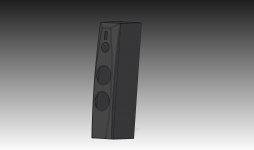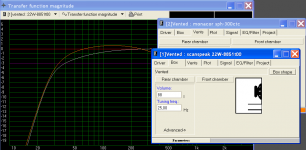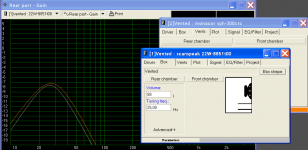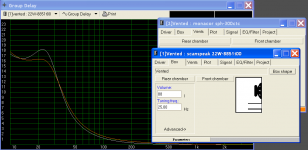It's also interesting to "tap" on them, without the amps being on, and listen to the signature of the diaphragm. More like "tapping" on metal driver than poly driver - even a traditional mineral loaded poly driver. Of course they also accommodate other diaphragms as well - even of your own manufacture.
To be more exact, I remember Per saying the standard cones are a Magnesium silicate filled polypropylene. They are different to the old Scanspeak and Vifa poly cones which are often described as soft sounding.
I wish they offered different cone materials options but really the only way to explore this option is to have them made yourself and then assembled by them = extremely expensive. Companies such as Sonus Faber and Rockport do this though.
To be more exact, I remember Per saying the standard cones are a Magnesium silicate filled polypropylene. They are different to the old Scanspeak and Vifa poly cones which are often described as soft sounding.
I wish they offered different cone materials options but really the only way to explore this option is to have them made yourself and then assembled by them = extremely expensive. Companies such as Sonus Faber and Rockport do this though.
Yes. I think though that the Magnesium silicate is *very* small in size and presents almost as a "sheet" of metal rather than typically loaded aggregate.
I have some drivers (not AT) that are heavily Graphite injected poly - which are even more different. Closest thing I've heard to them is certain variations on Audax's Aerogel - though less damped and even better at decay. Personally I'd wish that AT would move to that material.
To be more exact, I remember Per saying the standard cones are a Magnesium silicate filled polypropylene. They are different to the old Scanspeak and Vifa poly cones which are often described as soft sounding.
I wish they offered different cone materials options but really the only way to explore this option is to have them made yourself and then assembled by them = extremely expensive. Companies such as Sonus Faber and Rockport do this though.
Tap the centre dome/cap of a dynaudio bass mid and it sounds closer to pressed metal cones than typical vacuum formed polypropylene cones.
I did not build the speakers myself but I have used/owned and heard a lot of Dynaudio speakers and drivers.
The Dynaudio bass mid drive units are Magnesium silicate filled polypropylene, I found the speakers with dynaudio drivers that sounded the best were those with the crossover frequency kept as low as possible, otherwise they had a tiring/fatiguing ringing/resonance in the mid which gave them a steely quality on some material, especially vocals.
Perhaps a higher order crossover would have sorted this.
Detail was excellent for poly drivers. the sound was not always quite as lively and vibrant as with metal and paper cone drivers I have used but they certainly had their plus points.
Hi Everyone,
I have spent the last week doing some extensive reading and research on which drivers to use for my high-end 3-way project and thanks in part to your contribution in this forum I have made a decision to go with the alternative 1 option shown in my first post.
I want to give a special “thank you” to “ShinOBIWAN” for sharing his experience with the RAAL ribbons and the ScanSpeak beryllium dome.
I scrapped the alternative 2 because with its chosen woofer configuration it still would require some fairly large enclosures and why not then go for a pure 8” woofer instead? I’m really excited about the anticipated performance of ScanSpeak 8” woofers. Another thing is that there are a lot of nice designs done with these drivers, like e.g. Troels “Ekta” and “Ekta Grande” and I don’t want to copy others builds even though they inspire me in my project.
I scrapped the alternative 3 because I couldn’t find enough information about the Illuminator series in my research. I couldn’t find any consistent information that they would be a better choice than the Revelator series. On the contrary some people thought subjectively in listening tests that it had less performance compared to the Revelator series. These woofers would also require fairly large enclosures.
Ok, I choose the alternative 1, but everything isn’t done yet. Despite that I’ve chosen the ScanSpeak 8” woofers for the design the project has expanded to 3 woofers, 2 mid-woofers and 3 tweeter configuration options.
Still, I am very interested in information about the drivers below and if any of you has an opinion, first-hand experience and/or measurements etc. to share.
This is the current possibel configurations that I will use for the 3-way project:
Alternative 1:
Tweeter option1 (RAAL): 1x RAAL 140-15D
Tweeter option2 (BE): 1x ScanSpeak D3004/664000
Tweeter option3 (AC): 1x ScanSpeak D3004/660000
http://www.raalribbon.com/download/raal_140-15d.pdf
http://www.scan-speak.dk/datasheet/pdf/d3004-664000.pdf
http://www.scan-speak.dk/datasheet/pdf/d3004-660000.pdf
Mid: 1x ScanSpeak 15M/4531K00
http://www.scan-speak.dk/datasheet/pdf/15m-4531k00.pdf
Woofer (PAPER): 2x ScanSpeak 22W/8851T00
http://www.scan-speak.dk/datasheet/pdf/22w-8851t00.pdf
Estimated driver unit price/pair: 2560€ (RAAL), 2440€ (BE), 1940€ (AC)
Alternative 2:
Tweeter option1 (RAAL): 1x RAAL 140-15D
Tweeter option2 (BE): 1x ScanSpeak D3004/664000
Tweeter option3 (AC): 1x ScanSpeak D3004/660000
http://www.raalribbon.com/download/raal_140-15d.pdf
http://www.scan-speak.dk/datasheet/pdf/d3004-664000.pdf
http://www.scan-speak.dk/datasheet/pdf/d3004-660000.pdf
Mid: 1x ScanSpeak 15M/4531K00
http://www.scan-speak.dk/datasheet/pdf/15m-4531k00.pdf
Woofer (ALU): 2x ScanSpeak 22W/8857T00
http://www.scan-speak.dk/datasheet/pdf/22w-8857t00.pdf
Estimated driver unit price/pair: 2470€ (RAAL), 2360€ (BE), 1860€ (AC)
Alternative 3:
Tweeter option1 (RAAL): 1x RAAL 140-15D
Tweeter option2 (BE): 1x ScanSpeak D3004/664000
Tweeter option3 (AC): 1x ScanSpeak D3004/660000
http://www.raalribbon.com/download/raal_140-15d.pdf
http://www.scan-speak.dk/datasheet/pdf/d3004-664000.pdf
http://www.scan-speak.dk/datasheet/pdf/d3004-660000.pdf
Midwoofer: 1x ScanSpeak 15W/4531G00
http://www.scan-speak.dk/datasheet/pdf/15w-4531g00.pdf
Woofer (PAPER): 1x ScanSpeak 22W/4851T00
http://www.scan-speak.dk/datasheet/pdf/22w-4851t00.pdf
Estimated driver unit price/pair: 1975€ (RAAL), 1860€ (BE), 1360€ (AC)
Comments:
Tweeter options:
After spoken to ShinOBIWAN, there is only one ribbon tweeter that’s an option in this project and that’s the RAAL 140-15D. The smaller RAAL just wouldn’t fit in this design. The distortion profile of it suggests a much higher cross-over frequency than I intend to use. ShinOBIWAN also caught my interest of the ScanSpeak Beryllium tweeter D3004/664000. I’m not a huge fan of hard dome tweeters, but this one looks interesting with a cone-breakup as high up as 35kHz. Dome break-ups is my main concern with hard domes. It has a remarkable low distortion profile and the frequency charts also looks promising. On the other hand it’s almost as expensive as the RAAL and still, my heart screams “RAAL”.
If I choose a dome tweeter on the other hand I could start with the excellent ScanSpeak AirCirc D3004/660000 tweeter and then later on if I want to upgrade to the Beryllium, rebuild the cross-over without the need of rebuilding the loudspeaker enclosure.
Woofer and midrange options:
The main difference between alternative 1 & 2 is the material choice of the woofer, paper v.s aluminum. Alternative 1 would be suitable for a bass-reflex version of the loudspeaker. Alternative 2, the 8” ALU version is more suitable in a closed box version of the enclosure. Alternative 2 would also make an attractive option to use some EQ in the bottom to extend the low frequencies and perhaps reduce the enclosure size.
Alternative 3 would be the cheap and smaller version of the project, at least relatively. In this alternative I will use the 4 ohm version of the 8” paper woofer in order to gain some sensitivity. At the same time the higher sensitivity of the 15M/4531K00 midrange isn’t needed here and I can use the mid-woofer 15W/4531G00 instead. In this way I might avoid padding down the midrange, which I don’t like. Another bonus with alternative 3 is that I already own a pair of 15W and only needs to buy the woofers and tweeters
In this alternative I will use the 4 ohm version of the 8” paper woofer in order to gain some sensitivity. At the same time the higher sensitivity of the 15M/4531K00 midrange isn’t needed here and I can use the mid-woofer 15W/4531G00 instead. In this way I might avoid padding down the midrange, which I don’t like. Another bonus with alternative 3 is that I already own a pair of 15W and only needs to buy the woofers and tweeters 
This is about how far I have come in my design sketching so far. I shall begin some box simulations for the above 3 alternatives based on the T/S parameter I have so far found in my research.
I will post the box simulations as soon as I can.
Regards
/Goran
I have spent the last week doing some extensive reading and research on which drivers to use for my high-end 3-way project and thanks in part to your contribution in this forum I have made a decision to go with the alternative 1 option shown in my first post.
I want to give a special “thank you” to “ShinOBIWAN” for sharing his experience with the RAAL ribbons and the ScanSpeak beryllium dome.
I scrapped the alternative 2 because with its chosen woofer configuration it still would require some fairly large enclosures and why not then go for a pure 8” woofer instead? I’m really excited about the anticipated performance of ScanSpeak 8” woofers. Another thing is that there are a lot of nice designs done with these drivers, like e.g. Troels “Ekta” and “Ekta Grande” and I don’t want to copy others builds even though they inspire me in my project.
I scrapped the alternative 3 because I couldn’t find enough information about the Illuminator series in my research. I couldn’t find any consistent information that they would be a better choice than the Revelator series. On the contrary some people thought subjectively in listening tests that it had less performance compared to the Revelator series. These woofers would also require fairly large enclosures.
Ok, I choose the alternative 1, but everything isn’t done yet. Despite that I’ve chosen the ScanSpeak 8” woofers for the design the project has expanded to 3 woofers, 2 mid-woofers and 3 tweeter configuration options.
Still, I am very interested in information about the drivers below and if any of you has an opinion, first-hand experience and/or measurements etc. to share.
This is the current possibel configurations that I will use for the 3-way project:
Alternative 1:
Tweeter option1 (RAAL): 1x RAAL 140-15D
Tweeter option2 (BE): 1x ScanSpeak D3004/664000
Tweeter option3 (AC): 1x ScanSpeak D3004/660000
http://www.raalribbon.com/download/raal_140-15d.pdf
http://www.scan-speak.dk/datasheet/pdf/d3004-664000.pdf
http://www.scan-speak.dk/datasheet/pdf/d3004-660000.pdf
Mid: 1x ScanSpeak 15M/4531K00
http://www.scan-speak.dk/datasheet/pdf/15m-4531k00.pdf
Woofer (PAPER): 2x ScanSpeak 22W/8851T00
http://www.scan-speak.dk/datasheet/pdf/22w-8851t00.pdf
Estimated driver unit price/pair: 2560€ (RAAL), 2440€ (BE), 1940€ (AC)
Alternative 2:
Tweeter option1 (RAAL): 1x RAAL 140-15D
Tweeter option2 (BE): 1x ScanSpeak D3004/664000
Tweeter option3 (AC): 1x ScanSpeak D3004/660000
http://www.raalribbon.com/download/raal_140-15d.pdf
http://www.scan-speak.dk/datasheet/pdf/d3004-664000.pdf
http://www.scan-speak.dk/datasheet/pdf/d3004-660000.pdf
Mid: 1x ScanSpeak 15M/4531K00
http://www.scan-speak.dk/datasheet/pdf/15m-4531k00.pdf
Woofer (ALU): 2x ScanSpeak 22W/8857T00
http://www.scan-speak.dk/datasheet/pdf/22w-8857t00.pdf
Estimated driver unit price/pair: 2470€ (RAAL), 2360€ (BE), 1860€ (AC)
Alternative 3:
Tweeter option1 (RAAL): 1x RAAL 140-15D
Tweeter option2 (BE): 1x ScanSpeak D3004/664000
Tweeter option3 (AC): 1x ScanSpeak D3004/660000
http://www.raalribbon.com/download/raal_140-15d.pdf
http://www.scan-speak.dk/datasheet/pdf/d3004-664000.pdf
http://www.scan-speak.dk/datasheet/pdf/d3004-660000.pdf
Midwoofer: 1x ScanSpeak 15W/4531G00
http://www.scan-speak.dk/datasheet/pdf/15w-4531g00.pdf
Woofer (PAPER): 1x ScanSpeak 22W/4851T00
http://www.scan-speak.dk/datasheet/pdf/22w-4851t00.pdf
Estimated driver unit price/pair: 1975€ (RAAL), 1860€ (BE), 1360€ (AC)
Comments:
Tweeter options:
After spoken to ShinOBIWAN, there is only one ribbon tweeter that’s an option in this project and that’s the RAAL 140-15D. The smaller RAAL just wouldn’t fit in this design. The distortion profile of it suggests a much higher cross-over frequency than I intend to use. ShinOBIWAN also caught my interest of the ScanSpeak Beryllium tweeter D3004/664000. I’m not a huge fan of hard dome tweeters, but this one looks interesting with a cone-breakup as high up as 35kHz. Dome break-ups is my main concern with hard domes. It has a remarkable low distortion profile and the frequency charts also looks promising. On the other hand it’s almost as expensive as the RAAL and still, my heart screams “RAAL”.
If I choose a dome tweeter on the other hand I could start with the excellent ScanSpeak AirCirc D3004/660000 tweeter and then later on if I want to upgrade to the Beryllium, rebuild the cross-over without the need of rebuilding the loudspeaker enclosure.
Woofer and midrange options:
The main difference between alternative 1 & 2 is the material choice of the woofer, paper v.s aluminum. Alternative 1 would be suitable for a bass-reflex version of the loudspeaker. Alternative 2, the 8” ALU version is more suitable in a closed box version of the enclosure. Alternative 2 would also make an attractive option to use some EQ in the bottom to extend the low frequencies and perhaps reduce the enclosure size.
Alternative 3 would be the cheap and smaller version of the project, at least relatively.
This is about how far I have come in my design sketching so far. I shall begin some box simulations for the above 3 alternatives based on the T/S parameter I have so far found in my research.
I will post the box simulations as soon as I can.
Regards
/Goran
Glad I could help and it sounds like your narrowing down your choices. I'd go with option 1 and if your looking for something a little different then the RAAL.
Yes, that's my primary track right now, but I will see how the box sims unfold....
If it is gong to be "super high end", then the group delay, the impedance irregularities and all other weaknesses of the bass reflex enclosures should be excluded from the design, thus excluding the bass reflex option.
According to people like Linkwitz and E.J. Jordan, the best option is in wall speakers, second best is the aperiodic enclosure, third best is the closed box and OB or dipoles are as good as any of the three with some well known shortcomings. This is very generally speaking, but it's like this.
I would choose the sealed box option and use it with active crossover, separate amplifier and Linkwitz Transform equalization. Such enclosure can be very small, but then the power requirement would go sky high, 20 hz @ -20 db would require 100 times the power needed for equal SPL at the first frequency outside the equalized region. So with 90 db/w/m if 1 watt at 100 hz is enough for 90 db, at 35 hz you will need 10 watts and at 20 hz, you will need 100 watts for the same 90 db SPL. - The example is of an actual system that I design right now (12 in 35 hz Fs in 50L).
In my case, doubling the enclosure size (50 to 100L) nearly halves the power requirement and with the same power the system would be able to reproduce 16 hz at 90 db SPL instead of just 20
But if you use another driver, for instance 15 inch higher Qms, heavier cone, lower Fs (16.6 hz Fs to be specific), the power requirement goes even lower and now the same power is sufficient for 13.5 hz at 90 db and the enclosure is only 65L. That system would require only 20 watts for 90 db@20 hz and it is of the same size, but has much more headroom with 2.4 mm excursion at that level (2.4 out of 8mm total).
Such decision on the bass section design would require bigger midrange, but I better stop now or else I will redesign your system
Best Regards!
According to people like Linkwitz and E.J. Jordan, the best option is in wall speakers, second best is the aperiodic enclosure, third best is the closed box and OB or dipoles are as good as any of the three with some well known shortcomings. This is very generally speaking, but it's like this.
I would choose the sealed box option and use it with active crossover, separate amplifier and Linkwitz Transform equalization. Such enclosure can be very small, but then the power requirement would go sky high, 20 hz @ -20 db would require 100 times the power needed for equal SPL at the first frequency outside the equalized region. So with 90 db/w/m if 1 watt at 100 hz is enough for 90 db, at 35 hz you will need 10 watts and at 20 hz, you will need 100 watts for the same 90 db SPL. - The example is of an actual system that I design right now (12 in 35 hz Fs in 50L).
In my case, doubling the enclosure size (50 to 100L) nearly halves the power requirement and with the same power the system would be able to reproduce 16 hz at 90 db SPL instead of just 20
But if you use another driver, for instance 15 inch higher Qms, heavier cone, lower Fs (16.6 hz Fs to be specific), the power requirement goes even lower and now the same power is sufficient for 13.5 hz at 90 db and the enclosure is only 65L. That system would require only 20 watts for 90 db@20 hz and it is of the same size, but has much more headroom with 2.4 mm excursion at that level (2.4 out of 8mm total).
Such decision on the bass section design would require bigger midrange, but I better stop now or else I will redesign your system
Best Regards!
If it is gong to be "super high end", then the group delay, the impedance irregularities and all other weaknesses of the bass reflex enclosures should be excluded from the design, thus excluding the bass reflex option.
Hi T101,
Thanks you for your extensive comments and calculation examples.
I’m aware of that the word “high-end” is a cliché word which means different things for different people and I might have used a to strong word “super” in my post title, but what I’m trying to do is designing a “high-end” speaker, at least by my standards.
My reason for having the closed box alternative as an option is because I have the possibility to do both digital EQ and room correction in the low frequencies with my DEQX pre-amp.
The alu version of the 8” driver seems to be more suitable in a closed box alignment than the paper version. However the alu version do seems to require a larger enclosure. My idea is to reduce the box volume by approximately 20% in order to achieve the same internal box volume as the 8” paper version and then apply some EQ to achieve an extended low frequency.
That’s fine as long as I use some sort active electronics, but I also want to eventually build a passive version of the loudspeaker and without using e.g. the DEQX hardware. That complicates things a bit. Therefor I will probably build alternative 1 or 3 with the 8” paper cone. It’s more flexible in this way. First I could build a bass-reflex version and then if I feel for it, stuff the bass-reflex port and apply some Digital EQ etc. and then ”magic”, a closed box version
I haven't done enough research and simulations to be able to decide yet, but your comments were very insightful reading.
Regards
/Goran
Last edited:
If you havent already done so, take a look at the Sony SS-AR1 for some inspiration ....
Brochure
https://dealersource.sel.sony.com/dsweb/p/ar1/assets/SS-AR1_Brochure_Final.pdf
Whitepaper
https://dealersource.sel.sony.com/dsweb/p/ar1/assets/SS-AR1_WhitePaper_Final_LoRes.pdf
An externally hosted image should be here but it was not working when we last tested it.
Brochure
https://dealersource.sel.sony.com/dsweb/p/ar1/assets/SS-AR1_Brochure_Final.pdf
Whitepaper
https://dealersource.sel.sony.com/dsweb/p/ar1/assets/SS-AR1_WhitePaper_Final_LoRes.pdf
Last edited:
If you havent already done so, take a look at the Sony SS-AR1 for some inspiration ....
Yes, thank you. I've seen it and it looks like the design I might do, but with a different tweeter.
I must be realistic in what I can hand-build myself and the Sony enclosure design seems doable.
Regards
/Goran
Last edited:
I'd be inclined to build it as a 2 part enclosure - the 2-way top section, and the bass enclosure.
It will make the build easier to deal with and also makes future upgrades easier.
I use the Scanspeak 15W in my surround speakers and enjoy them tremendously.
The Scanspeak 26W revelator I used in a previous design was also beyond reproach. My newer speakers use the Morel Ultimo which is getting into subwoofer territory.
My thoughts are that in the scheme of things, given the amount of time and effort put into a design, the driver cost is small.
You cant go wrong with the Scanspeaks.
It will make the build easier to deal with and also makes future upgrades easier.
I use the Scanspeak 15W in my surround speakers and enjoy them tremendously.
The Scanspeak 26W revelator I used in a previous design was also beyond reproach. My newer speakers use the Morel Ultimo which is getting into subwoofer territory.
My thoughts are that in the scheme of things, given the amount of time and effort put into a design, the driver cost is small.
You cant go wrong with the Scanspeaks.
Last edited:
I had a look (but no listen unfortunately) at the AR1 when I visited the Sony building in Tokyo. It, and the Rockport Mira are the visual inspiration behind my current build.
It's not quite as high-end or as big as what you are planing but similar in some respects.
I chose the RAAL 70-10, Scan Speak 10F and 2 x Wavecor SW182's.
It's a shame the 70-20 isn't available to you as it would probably be perfect for what you are doing. Either way, you'd be doing yourself a favor to go with RAAL. Aleksandar is a pleasure to deal with and really goes out of his way to support his product.
My drivers will be rear mounted. Here's a pic: (Sorry, no Shin spec rendering here )
)
It's not quite as high-end or as big as what you are planing but similar in some respects.
I chose the RAAL 70-10, Scan Speak 10F and 2 x Wavecor SW182's.
It's a shame the 70-20 isn't available to you as it would probably be perfect for what you are doing. Either way, you'd be doing yourself a favor to go with RAAL. Aleksandar is a pleasure to deal with and really goes out of his way to support his product.
My drivers will be rear mounted. Here's a pic: (Sorry, no Shin spec rendering here
Attachments
I'm really interested if anyone has experience with the ScanSpeak 22W/8851T00 8" woofer, measurements, sonic character, optimal enclosure volume etc.
I don’t need a super sub-sonic response, but I want a fast dynamic response character if you know what I mean.
/Goran
I have no experience with ScanSpeak drivers, but your second comment to me about "fast and dynamic" means looking to high sensitivity professional drivers, not HiFi drivers...
Whoops... never mind. You've already decided...
Last edited:
Fast calls for low Cms (mm/n), High Qms, low cone weight, low Qts with high BL. - A description that matches some pro 12 midwoofers or a 12 full range with relatively high Fs.
Recently I obtained a pair of 12 in extended ranges (80-12500 hz @ 95-96 db/w/m), the transient and impulse response is such that percussions are startling. - Light and rigid paper cone, low losses suspension (high Qms), ~70 hz Fs (acordeon paper surround - one piece with the membrane).
I think of something like this: http://www.eminence.com/pdf/Legend_CB15.pdf
With front loading slot or small front chamber with 1/2 Sd opening (lowers Fs and increases bass energy) and a sealed enclosure with Linkwitz Transform behind.
And this has even lower EBP http://www.eminence.com/pdf/LAB_15.pdf
And something like the Beta 12 LTA, not the beta, but something with higher Fs and better behaving membrane. Or maybe an Audio Nirvana with stifer suspension.
Sorry for the spam.
Recently I obtained a pair of 12 in extended ranges (80-12500 hz @ 95-96 db/w/m), the transient and impulse response is such that percussions are startling. - Light and rigid paper cone, low losses suspension (high Qms), ~70 hz Fs (acordeon paper surround - one piece with the membrane).
I think of something like this: http://www.eminence.com/pdf/Legend_CB15.pdf
With front loading slot or small front chamber with 1/2 Sd opening (lowers Fs and increases bass energy) and a sealed enclosure with Linkwitz Transform behind.
And this has even lower EBP http://www.eminence.com/pdf/LAB_15.pdf
And something like the Beta 12 LTA, not the beta, but something with higher Fs and better behaving membrane. Or maybe an Audio Nirvana with stifer suspension.
Sorry for the spam.
If you like real bass I mean subbas. A closed box will never be high-end without active correction.If it is gong to be "super high end", then the group delay, the impedance irregularities and all other weaknesses of the bass reflex enclosures should be excluded from the design, thus excluding the bass reflex option.
You can design a BR with group delay around 20Hz You cannot hear that, and have much better bass-response as you can get closed. I think closed box lovers confuse sub-bas with less controlled bas.
Here a example of a high-end carbon subbas monacor sph300ctc as you see the comment on the impedance and phase is wrong. Higher group delay as closed box only below 35hz. with the port placed on the back you get subbas down 20hz in 63 liter.
To make good basreflex you need a big port 30% or >Sd.

Attachments
-
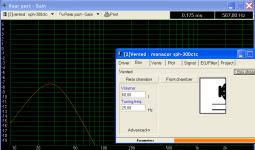 Schermafbeelding 2011-10-05 om 17.26.56.png38 KB · Views: 734
Schermafbeelding 2011-10-05 om 17.26.56.png38 KB · Views: 734 -
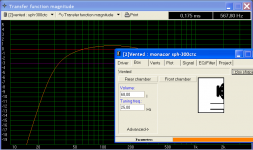 Schermafbeelding 2011-10-05 om 17.26.25.png38.8 KB · Views: 731
Schermafbeelding 2011-10-05 om 17.26.25.png38.8 KB · Views: 731 -
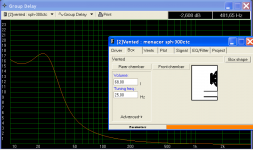 Schermafbeelding 2011-10-05 om 17.24.25.png39.6 KB · Views: 662
Schermafbeelding 2011-10-05 om 17.24.25.png39.6 KB · Views: 662 -
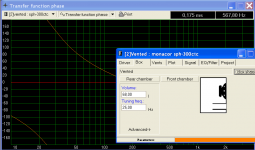 Schermafbeelding 2011-10-05 om 17.34.31.png38.2 KB · Views: 92
Schermafbeelding 2011-10-05 om 17.34.31.png38.2 KB · Views: 92 -
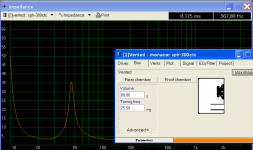 Schermafbeelding 2011-10-05 om 17.34.10.png36.6 KB · Views: 885
Schermafbeelding 2011-10-05 om 17.34.10.png36.6 KB · Views: 885
Last edited:
I'd be inclined to build it as a 2 part enclosure - the 2-way top section, and the bass enclosure.
It will make the build easier to deal with and also makes future upgrades easier..
Yes, you’re right. I might do that; at least will I give it some serious thoughts. There is a long way ahead before the enclosure design is to be decided.
Yes, I also love the Scanspeak 15W, they do something absolutely right in the midrange, I think.
My thoughts are that in the scheme of things, given the amount of time and effort put into a design, the driver cost is small.
I agree
/Goran
I had a look (but no listen unfortunately) at the AR1 when I visited the Sony building in Tokyo. It, and the Rockport Mira are the visual inspiration behind my current build.
It's not quite as high-end or as big as what you are planing but similar in some respects.
I chose the RAAL 70-10, Scan Speak 10F and 2 x Wavecor SW182's.
It's a shame the 70-20 isn't available to you as it would probably be perfect for what you are doing. Either way, you'd be doing yourself a favor to go with RAAL. Aleksandar is a pleasure to deal with and really goes out of his way to support his product.
My drivers will be rear mounted. Here's a pic: (Sorry, no Shin spec rendering here)
Very nice
/Goran
Here a sim of two 22w-8851t00 in a BR compared to the sph300ctc. As you can see they are quite similar.
Attachments
Last edited:
Agreed! 
Then guess why I have made a 220L bass reflex tuned below 20 hz... in order to push the GD peak well below 30 hz
 and it is a 15 in driver with 270 cm2 port.
and it is a 15 in driver with 270 cm2 port.
I didn't mention monster cabinets with big low Fs, low Qts, high Qms woofers, because here the author is choosing between 60 and 80L enclosures. (see p. 2. of the thread in my signature)
This Monacor looks and sims pretty well, it might be a good candidate for the system discussed here since it has so modest enclosure volume claims.
But again, this impedance peak just below 50 hz frightens me. After I have listened to sealed, aperiodic and H-frame dipole bass, the reflex enclosures loose their appeal to me more and more.
This driver: http://www.scan-speak.dk/datasheet/pdf/22w-4851t00.pdf
Does 25 hz @ -10 db relative to 100 hz as zero point and does 94 db@ 25 hz @ Xmax @ 40 W in 65 L sealed and heavily stuffed cabinet.
With two drivers in the same 65L cabinet, max power handling (Xmax limited) at 25 hz goes to 90 watts and the SPL goes to 99.4 db which is just 10.7 db quieter than 100 hz (25 hz @-10.7 db).
Looks pretty well. And all that at less than 5ms GD.
Definitely sealed!
Now put a passive crossover around 100 hz to it and watch how everything gets ruined.
I like that article, it shows, that equalisation does not lead to greater power consumption, it just helps you to reach Xmax earlier Electrical and mechanical limits
Electrical and mechanical limits
Simulations show, that xmax will be reached at 90W sine wave, but in reality music signals have impulse character and content under 30 hz is very little so it should not be a concern.
I vote for the Revelator 22W, it does not matter which membrane material at those frequencies, so I vote for the less expensive.
For high frequencies I vote for ribbon, but crossed over higher, at least 6-7 khz.
Only concern is the midrange, maybe that crossed as high as possible: http://www.scan-speak.dk/datasheet/pdf/12mu-4731t00.pdf
But all proposed midranges seem small to me. Maybe a higher efficiency ''8 midrange, maybe in omnidirectional configuration. But in the omnidirectional case, the ribbon tweeter is declined as it is not symetrical and cannot be used with 360 degree reflector.
High end should be bizarre and technically advanced with typical flaws addressed. A typical flaw is the off axis energy distribution. With omnidirectional designs, typically you get falling response towards the HF, because what was beamed before, now is evenly distributed across the listening space. But the overall presence of the high frequencies in the room remains the same, because the emitted energy is the same it's just not focused at you anymore. With omnidirectional you could very conveniently mate the midrange to a tweeter with rising response and end with flat SPL response throughout.
Best Regards!
Then guess why I have made a 220L bass reflex tuned below 20 hz... in order to push the GD peak well below 30 hz
I didn't mention monster cabinets with big low Fs, low Qts, high Qms woofers, because here the author is choosing between 60 and 80L enclosures. (see p. 2. of the thread in my signature)
This Monacor looks and sims pretty well, it might be a good candidate for the system discussed here since it has so modest enclosure volume claims.
But again, this impedance peak just below 50 hz frightens me. After I have listened to sealed, aperiodic and H-frame dipole bass, the reflex enclosures loose their appeal to me more and more.
This driver: http://www.scan-speak.dk/datasheet/pdf/22w-4851t00.pdf
Does 25 hz @ -10 db relative to 100 hz as zero point and does 94 db@ 25 hz @ Xmax @ 40 W in 65 L sealed and heavily stuffed cabinet.
With two drivers in the same 65L cabinet, max power handling (Xmax limited) at 25 hz goes to 90 watts and the SPL goes to 99.4 db which is just 10.7 db quieter than 100 hz (25 hz @-10.7 db).
Looks pretty well. And all that at less than 5ms GD.
Definitely sealed!
Now put a passive crossover around 100 hz to it and watch how everything gets ruined.
I like that article, it shows, that equalisation does not lead to greater power consumption, it just helps you to reach Xmax earlier
Simulations show, that xmax will be reached at 90W sine wave, but in reality music signals have impulse character and content under 30 hz is very little so it should not be a concern.
I vote for the Revelator 22W, it does not matter which membrane material at those frequencies, so I vote for the less expensive.
For high frequencies I vote for ribbon, but crossed over higher, at least 6-7 khz.
Only concern is the midrange, maybe that crossed as high as possible: http://www.scan-speak.dk/datasheet/pdf/12mu-4731t00.pdf
But all proposed midranges seem small to me. Maybe a higher efficiency ''8 midrange, maybe in omnidirectional configuration. But in the omnidirectional case, the ribbon tweeter is declined as it is not symetrical and cannot be used with 360 degree reflector.
High end should be bizarre and technically advanced with typical flaws addressed. A typical flaw is the off axis energy distribution. With omnidirectional designs, typically you get falling response towards the HF, because what was beamed before, now is evenly distributed across the listening space. But the overall presence of the high frequencies in the room remains the same, because the emitted energy is the same it's just not focused at you anymore. With omnidirectional you could very conveniently mate the midrange to a tweeter with rising response and end with flat SPL response throughout.
Best Regards!
Last edited:
A peak at 10Hz who cares, you can use a zobel LCR to damp it.Agreed!
This Monacor looks and sims pretty well, it might be a good candidate for the system discussed here since it has so modest enclosure volume claims.
But again, this impedance peak just below 50 hz frightens me. After I have listened to sealed, aperiodic and H-frame dipole bass, the reflex enclosures loose their appeal to me more and more.
(I use now dipole bass 2X15" 94dB 1W -3dB 30-35Hz depends on placement.)
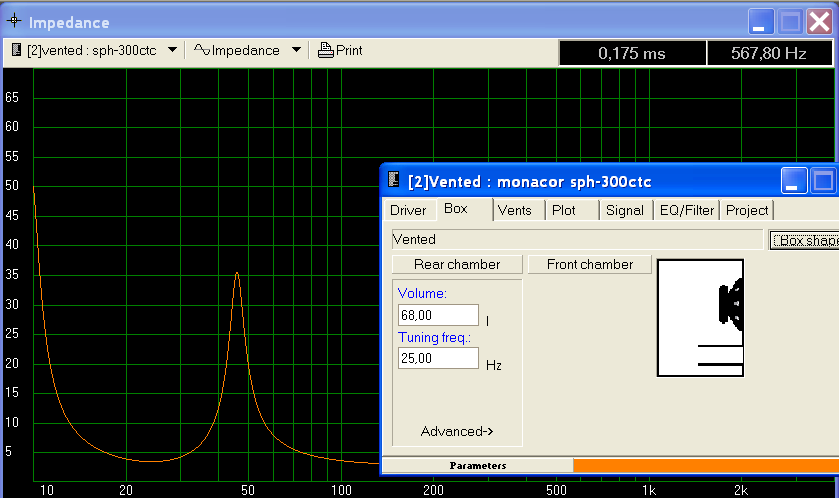
- Status
- This old topic is closed. If you want to reopen this topic, contact a moderator using the "Report Post" button.
- Home
- Loudspeakers
- Multi-Way
- Super High-End 3-way floor-stander
